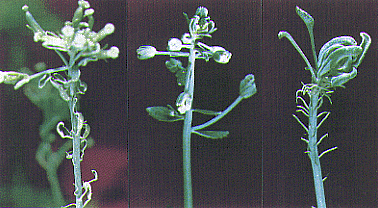National Insitute for Basic Biology

National Insitute for Basic Biology


|
| Filamentous flower mutant forms clusters of deformed flowers and of filaments with a sepal-like structure at its top (left). In leafy mutant, flowers are homeotically transformed to shoots (middle). A double mutant carrying mutations in both FILAMENTOUS FLOWER and LEAFY genes fails to generate either flowers or shoots, and instead continues to form filaments and sepal-like structures (right). |